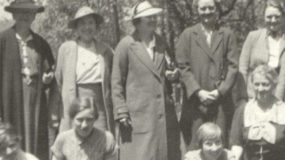Fields of the History of Women, Gender, and/or Sexuality | Any Field of History
2025 Article Prize Committee Members
Katrina Gulliver, Foundation for Economic Education, Chair
Silvia Arrom, Brandeis University
Anna Danziger Halperin, New-York Historical Society
Jessica Davidson, James Madison University
Patricia Harms, Brandon University
Evan Elizabeth Hart, Missouri Western State University
Jillian Jacklin, University of Wisconsin, Green Bay
Cherisse Jones-Branch, Arkansas State University
Kelly O’Donnell, Towson University
Deepasri Baul, University of Illinois at Urbana-Champaign
Sarah Ifft Decker, Rhodes College
Deborah Hamer, New Netherland Institute
Marsha E. Barrett, University of Illinois at Urbana-Champaign
Jennifer Palmer, University of Georgia
An Article in the Fields of the History of Women, Gender, and/or Sexuality
2024>Cameron Blevins, Annelise Heinz. “’Separated, but far from alone’: Forging Lesbian Networks in the 1970s–1980s.” Pacific Historical Review 93, no. 3 (August 1, 2024): 417–444.
This winning article explores the histories of group connection among lesbians in the United States in the 1970s and 1980s. The authors’ approach demonstrated an impressive methodology, using mapping to explore their insights to the development of lesbian communities in the 70s and 80s. Their style allows their research to reach beyond their subfield. The committee also remarked on this article’s accessibility, and suitability to be assigned as a student reading. Blevins and Heinz narrated a nuanced history from a range of sources to approach their subjects in an original way.
Honorable Mention Julia Stephens. “Material modernities: Tracing Janbai’s gendered mobilities across the Indian Ocean.” Modern Asian Studies 58, no. 2 (2024): 386-420.
We felt that Julia Stephens’ expansive research deserved an honorable mention. This article showed a distinctive approach to sharing research, as one committee member put it, “letting us see under the hood”. This willingness to share the insights of historical process makes this essay a valuable resource to readers across the field. The range of field geographically and temporally takes the reader from the Indian Ocean, to Salem, Massachusetts and New Zealand. From the microhistory of one woman, the impact spreads to archives around the world.
2023> Sara Balakrishnan, “Prison of the Womb: Gender, Incarceration, and Capitalism on the Gold Coast of West Africa, c. 1500–1957,” Comparative Studies in Society and History, April 2003, 65-2:296-320
This stunning piece focuses on the carceral state in West Africa, from the early modern period into the twentieth century. The committee was struck particularly by the breadth and temporal scope of Balakrishnan’s research. Her study highlights the various forms of incarceration that could be faced, particularly by women, in counterpoint to the “official” forms in the colonial state. That this is an area that has not been studied thus far demonstrates the importance of a gendered lens on history, and how much colleagues like Balakrishnan are pushing the field forward.
Honorable Mention Sharon Block, “Rewriting the Rape of Rachel: Historical Methods, Historical Justice.” The William and Mary Quarterly. October 2023. Volume 80, Number 4. pp. 649-676.
In a competitive field, we wanted to also recognize Sharon Block’s thoughtful essay with an honorable mention. This self-reflection on a career’s work and changing theoretical approaches struck several of us as a perfect case study for students in theory and methods classes, as well as speaking to scholars at different stages of their research.
The committee felt the works by Balakrishnan and Block also complement each other, reflecting the best in our discipline, and how our fields continue to develop.
2022 > Meg Weeks, “A Prostitutes’ Jamboree: The World Whores’ Congresses of the 1980s and the Rise of a New Feminism.” Journal of the History of Sexuality, Vol. 31, Issue 3, September 2022.
Weeks explores the differing political philosophies (and tactics) of the groups who came together at the sex-worker conferences, and how they forged international alliances despite contrasting goals, and differing cultural contexts.
She considers the political conflicts within the movements to have had a galvanizing effect, “moving it beyond the classic impasse of structure versus agency that mired many a political debate in the twentieth century.”
2021 > Sandy F. Chang, “Intimate Itinerancy: Sex, Work, and Chinese Women in Colonial Malaya’s Brothel Economy, 1870s-1930s,” Journal of Women’s History 33, no. 4 (2021): 92-117.
Chang’s layered study of sex workers in the late nineteenth and early twentieth centuries draws on an impressive range of sources, from temple inscriptions to police reports. The committee was particularly struck by her ability to lace these different approaches into building a nuanced understanding of this community. Her focus on migrant workers is obviously relevant for scholars in other fields and we commend this powerful essay.
Honorable Mention Jacqueline Antonovich, “White Coats, White Hoods: The Medical Politics of the Ku Klux Klan in 1920s America,” Bulletin of the History of Medicine 95, no. 4 (2021): 437-463.
Antonovich’s work, focusing on reproductive surveillance, has continuing relevance – both for historians and those considering the world today. Her fluid style creates a narrative drawing in the reader, and her depth of scholarship brings forward another side to the race nationalism of the KKK.
2020 > Rosanna Dent, ‘Subject 01: exemplary Indigenous masculinity in Cold War genetics’, British Journal of the History of Science, 53 (3), September 2020
Rosanna Dent’s insightful work draws the history of the social sciences to recast our understanding of masculinities and aggression in the culture of the 1960s. She discusses the research on genetics at a time when popular conceptions of evolution were promoting an image of “natural” human masculinity, which some scholars believed could be identified in indigenous groups still living in tribal communities. A key debate among evolutionary biologists at this time was whether humans have a greater inclination to individual violence or to group cooperation.
She argues that research, focusing on indigenous peoples in Brazil, drove a particular vision of masculine violence: “The arguments which developed out of the research on Apöwẽ and Yanomami warfare promoted an individualistic evolutionary benefit to male aggression, setting up conditions for sociobiologists to frame violence as innate.”
She goes on to show that this research did real-world harms to the Yanomami, as it was instrumentalised by “Brazilian fazendeiros and politicians in an attempt to block the demarcation of a large unified Yanomami territory.”
Dent explores the persistent tendency in genetics (and popular science) to regard indigenous groups as living exemplars of the deep past, and the use of indigenous people as research subjects to demonstrate evolutionary claims.
2019 > Elisa Camiscioli, “Coercion and Choice: The ‘Traffic in Women’ between France and Argentina in the Early Twentieth Century,” French Historical Studies, Vol. 42, No. 3 (August 2019): 483-507.
2018 > Satyasikha Chakraborty, “European Nurses and Governesses in Indian Princely Households: “Uplifting that impenetrable veil”?” Journal of Colonialism and Colonial History 19/1 (Spring 2018).
2017 > Cassia Roth, “From Free Womb to Criminalized Woman: Fertility Control in Brazilian Slavery and Freedom.” Slavery & Abolition, 38:2
2016 > Amy Stanley, “Maidservants’ Tales: Narrating Domestic and Global History in Eurasia, 1600-1900,” American Historical Review, vol. 121, no. 2, March 2016, pp. 437-460.
The committee overwhelmingly agreed that Stanley’s “Maidservants’ Tales” stood out in a pool of very strong articles in this category because of her innovative integration of micro and global history, two “seemingly incompatible strategies” to illustrate, as she writes, the “small rebellions of ordinary people” which were “common” … “to women across Eurasia over three hundred years.” We found her writing to be highly engaging, and praised her ability to upend our assumptions about women’s lives in vastly different historical contexts. She demonstrates that women’s historians might highlight lives that at first glance appear unimportant because they are, in the case of this article, maidservants, a task performed by young women in broadly different geographical and historical contexts, but still use those lives to draw broad historical understandings.
2015 > Rebecca Jo Plant and Frances M. Clarke, “The Crowning Insult”; Federal Segregation and the Gold Star Mother and Widow Pilgrimages of the Early 1930s”; Journal of American History, 102: 2 (September 2015).
Plant and Clarke highlight the decline in African American status in interwar years, focusing on the “largely forgotten … discriminatory treatment” of mothers and widows of fallen United States soldiers. The federal government-sponsored segregated pilgrimages to Europe from 1930 to 1933 to visit the bodies of their fallen kin became part of an emotionally fraught debate over the limitations of citizenship rights of African Americans, claims of which had pivoted on notions of masculinity. Pressured to boycott the pilgrimages, the “so-called ordinary women” were “forced …to weigh powerful appeals to racial solidarity against deeply felt personal commitments and desires,” which often “signaled their independence from black leaders.” The article prize committee believes that Plant and Clarke compellingly give historical voice to African American women seldom heard from and whose perspectives “harbor[ed] dreams of a radically transformed society.”
2014 > Katherine Paugh, “Yaws, Syphilis, Sexuality, and the Circulation of Medical Knowledge in the British Caribbean and the Atlantic World,” in the Bulletin of the History of Medicine, Volume 88, Number 2, Summer 2014, pp. 225-252.
and
Carina Ray, “Decrying White Peril: Interracial Sex and the Rise of Anticolonial Nationalism in the Gold Coast,” appearing in the American Historical Review, February 2014.
2013 > Jaime Wadowiec, “Muslim Algerian Women and the Rights of Man: Islam and Gendered Citizenship in French Algeria at the End of Empire,” appearing in French Historical Studies, vol. 36, no. 4 (Fall 2013): 649-676.
An Article in Any Field of History
2024>Hannah Waits. “Missionary Positions: How American Evangelicals Learned to Love Global AIDS Work, 1985-2005.” American Quarterly 76, no. 4 (December 2024): 821-844.
Waits’ article explores the history of the American evangelical movement at the moment of the AIDS crisis. The committee found this original essay had the power to speak across the discipline. Crossing subfields from the histories of global humanitarianism, evangelical movements, public health, and the history of the emotions, Waits demonstrated a mastery of her archival sources and a sensitivity to her subject. This particular issue resonates with the current moment, but will continue to be a valuable piece of research for years to come.
Honorable Mention Tessa Murphy. “Centering Slavery in the Age of Abolition: Insights from the Saint Lucia Register of Plantation Slaves, 1815.” The William & Mary Quarterly 81, no. 2 (April 2024): 359-394.
In a competitive field, we wanted to also recognize Tessa Murphy’s impressive essay with an honorable mention. This article seeks to uncover histories of enslaved people on St Lucia. Tessa Murphy’s essay is an extraordinary work archivally, recovering silences and missing stories. Her intense research illustrates the uncovering of close family narratives and the broader project of archival access. Her work involved the creation of a searchable database for descendants, showing the relevance of her historical work to reach beyond the academic community.
2023 > Jennifer Robin Terry, “Niños por la causa: Child Activists and the United Farm Workers Movement, 1965-1975,” Pacific Historical Review, Vol. 92, Number 2, pps. 227–259.
The committee found Terry’s work to be original and innovative. She studies the participation of children in the UFW strikes and protests and the farm worker movement more generally. Children are often under-researched in history, and by making them the focus of her work she draws out themes of the social and familial impact of the UFW’s activism. Shifting the scholarly gaze to child protagonists is a technique that could inform work in other fields, particularly the rippling impact of much social change.
2022 > Samantha Payne, “A General Insurrection in the Countries with Slaves: The US Civil War and the Origins of an Atlantic Revolution, 1861-1866,” Past & Present, Vol. 257, Issue 1, November, 2022.
Payne foregrounds the actions of enslaved people in the debate about emancipation following the American Civil War and its ripple effects on the other slave states of the Americas. She argues the end of the Civil War precipitated the abolition of slavery in Cuba and Brazil because of the actions of these slaves.
Members of the Committee were impressed by the breadth of her research, with archives in several countries and multiple languages. By considering the communications network that existed among enslaved people and free people of color in the Atlantic world, she was able to consider how much their participation affected the changing discourse of emancipation.
By reading across the micro to the macro, the changing circumstances for both enslaved people and free people of color as increased surveillance and restrictions were enforced in the wake of the American Civil War in the remaining slave states of the Americas, where authorities were concerned that liberty was contagious. Her work brings into clearer view the role of black people in the pursuit of liberty and in the discourse of emancipation through the Atlantic World.
2021 > Adriana Chira, “Freedom with Local Bonds: Custom and Manumission in the Age of Emancipation,” The American Historical Review 121.3 (2021): 949-977.
The winning article demonstrated creativity in scholarship and expression. The committee found Chira’s work to be innovative in its approach and exploration of those seeking manumission from slavery. Considering social networks as a “resource” in the manumission process offers a new facet for understanding this matrix.
Chira also considers the grey area between enslaved and free, building on scholarship considering the nature of identity and freedom among enslaved peoples.
Honorable Mention Choon Hwee Koh, “The Ottoman Postmaster: Contractors, Communication and Early Modern State Formation,” Past & Present, Volume 251, Issue 1, May 2021, Pages 113–152.
Choon Hwee Koh impressed the committee with this paper discussing outsourcing of communication networks in the early bureaucratic age. Her study speaks beyond the Ottoman Empire of its focus to scholars studying state-building and control in other periods and places.
2020 > Amy Chazkel, ‘Toward a History of Rights in the City at Night: Making and Breaking the Nightly Curfew in Nineteenth-Century Rio de Janeiro’, Comparative Studies in Society and History, 62 (1), 2020
Amy Chazkel’s work uses temporality as a lens to explore the historical experience of Rio’s residents in the nineteenth century. Night criminalized activities for certain inhabitants–slaves or people who could be taken for slaves, women, foreigners–that were perfectly legal during the daytime. Her creative approach gave a literary flair to the piece, and the committee were particularly impressed with the way her tools could be used by other scholars.
She refers to her sources, police notebooks, as “glimpses through a tiny keyhole at nocturnal public culture before the era of Rio’s famed nightlife, before there was supposed to be any.” Scholars teasing out what existed where it wasn’t “supposed to” is a significant way of reading “across the archival grain”, and Chazkel shows how we can extrapolate a broader understanding of the field. In her case, this is an urban environment evolving alongside, and through, the development of modern policing, transport and technology.
2019 > Bathsheba Demuth, “The Walrus and the Bureaucrat: Energy, Ecology, and Making the State in the Russian and American Arctic, 1870-1950,” The American Historical Review, Vol. 124, No. 2 (April 2019): 483–510.
2018> Kimberly A. Arkin, “Historicity, Peoplehood, and Politics: Holocaust Talk in Twenty-First-Century France.” Comparative Studies in Society and History 60/4 (October 2018).
Yumi Kim, “Seeing Cages: Home Confinement in Early Twentieth-Century Japan.” The Journal of Asian Studies 77/3 (August 2018).
2017> Carole McGranahan, “Imperial but Not Colonial: Archival Truths, British India, and the Case of the “Naughty” Tibetans.” Comparative Studies in Society and History, vol 59, No 1.
Vanessa Ogle, “Archipelago Capitalism: Tax Havens, Offshore Money, and the State, 1950s-1970s,” American Historical Review, 122, no. 5.
2016 > Devra Anne Weber, “Wobblies of the Partido Liberal Mexicano: Reenvisioning Internationalist and Transnational Movements through Mexican Lenses,” Pacific Historical Review, 85, no. 2 (May 2016), 188-226.
The committee awarded this prize to Weber for her methodologically interesting approach which decenters the historical narrative of the Wobblies by using a transnational lens to focus on the labor activism of Mexican subjects in territory both north and south of the shifting US/Mexican border. As Weber points out and makes central to her lens, both the people and the border have moved over time. Her transnational focus highlights the diversity of the activists in terms of gender, linguistics, class, and ethnicity as people lived, worked, and organized to target “imperialism as well as industrial capitalism” … “across a transnational space.” She contends that by restricting the history of the IWW to national boundaries, historians have unwittingly marginalized a “complex, messy, multiethnic, and multilingual reality.” We also appreciated her multigenerational scope, which views history “through individuals, families, and communities” to reveal a “multigenerational transmission of values and activism” that reaches up to the present.
2015 > Debora L. Silverman, “Diasporas of Art: History, the Tervuren Royal Museum for Central Africa, and the Politics of Memory in Belgium, 1885–2014,” The Journal of Modern History 87: 3 (September 2015).
The article prize committee agreed that Silverman’s treatment of Belgium’s “colonial amnesia” about the period of King Leopold’s Congo Free State, contributes importantly to international conversations about the historical decontextualization of imperial violence, “demonstrating that patterns of collective forgetting are not unique to Belgium.” Examining the representation of vast collections of artifacts—a “diaspora of objects”—from the Royal Museum for Central Africa in Tervuren, near Brussels, as they recently traveled to the United States, Silverman demonstrates how the perpetuation of the erasure of the “brutal regime’s rampant violence” became a missed opportunity to link United States’ own history of slavery to Africa and the history of imperial violence and exploitation in the Congo. Instead, these exhibitions contributed to a “great forgetting” of the Belgian empire and its violent extractions.
2014 > Julia Phillips Cohen, “Oriental by Design: Ottoman Jews, Imperial Style, and the Performance of Heritage” in American Historical Review, April 2014.
2013 > Molly Loberg, “The Streetscape of Economic Crisis: Commerce, Politics, and Urban Space in Interwar Berlin,” Journal of Modern History, Vol 85, no. 2 (June 2013): 364-402.




